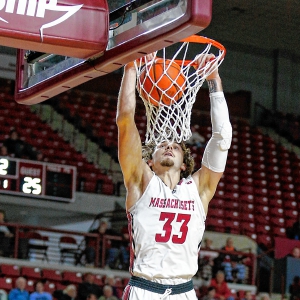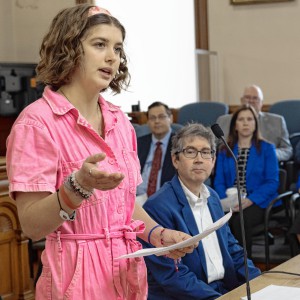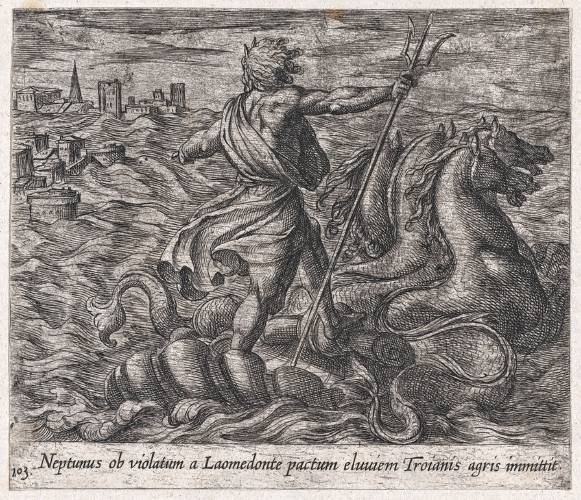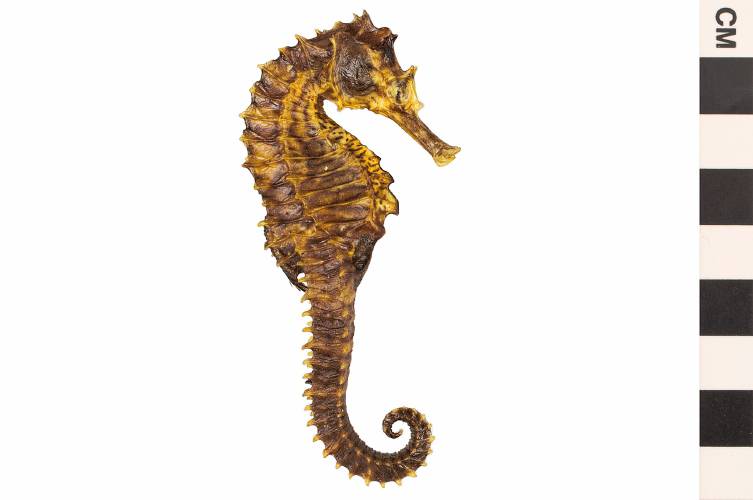Earth Matter: Unlike any other vertebrate: Exploring the strangeness of seahorses
| Published: 03-01-2024 11:50 AM |
Most vertebrates — the large group of animals that includes humans — have many features in common, but some oddball groups have lost some of those characteristics. For example, snakes have lost their limbs, but they retain most of the other features typical of the larger group. Some of the strangest of these animals, having lost or altered many of the usual vertebrate characteristics, are seahorses. Seahorses are named for their horse-like head shape, one of many distinctive traits, a few of which I compare with those of other vertebrates.
Vertebrates are named for a horizontal beam of skeletal elements, the vertebrae, that helps to support the animals as they move head-first. In a few unusual species, including seahorses and humans, this beam is rotated into an upright column, and the animal moves belly-first.
Protruding from that vertebral axis, two pairs of fins or limbs used for swimming or walking are found on most vertebrate animals. In some groups — including humans, bats and birds — one pair of limbs is highly specialized for unusual functions, like typing or flight. As mentioned above, snakes have lost their limbs, and some fish, including seahorses, have lost a pair of fins.
A muscular tail extends the vertebral axis behind the body’s torso, and is used by most vertebrates for swimming in water or for balance on land. That tail is greatly reduced in other groups with a vertical axis, like birds (which have feathers protruding beyond the very short bone and flesh tail) and humans. A few other vertebrates, including seahorses and New World monkeys, have tails modified for grasping. Seahorses spend much of their time hanging on to aquatic plants, corals, or any other grabbable substrate, and their relatively slow swimming is accomplished with their dorsal (back) fin and small front pair of fins.
With the exception of hagfish and lampreys, living vertebrates have upper and lower jaws that can generally be moved relative to each other to capture and process food. Don’t worry about a seahorse biting you; it can’t. Its jaws, fused into a tiny tube, have no independent motion and cannot grab food. Imagine eating only with a straw, eating only small items — like grains of rice or small beans — that could be drawn up individually through the straw. That gives an idea of a seahorse’s feeding, taking in nearly microscopic animals and eggs that pass within sucking distance of its snout.
What about that horse-like head? The similar high heads of horses and seahorses both accommodate relatively large muscles and long tendons, but with different functions. The muscles in a horse’s head move the lower jaw as it grinds grasses between massive teeth adapted to dealing with the tough cell walls and mineral crystals of its food. In contrast, a seahorse cannot move its jaws independently, and, as the animal tilts its head down, the muscles and tendons in its head store elastic energy, much as a stretched rubber band does. That elastic energy is suddenly released to snap the mouth up and nearer to tiny crustacean prey. As the seahorse snout moves rapidly (in a 400th of a second) into position, its narrow, elongated shape minimizes water movement that might alert its prey to take evasive action.
Female vertebrates either lay eggs to hatch outside their bodies (as do turtles and birds) or retain developing eggs to give birth to live young (as do guppies, great white sharks, rattlesnakes, and most mammals). A female seahorse also lays eggs, but she lays them into pouches on the belly of a male who, after incubating the eggs in his abdominal nest, gives birth to live young. Males of some seahorse species secrete nutritious substances from the pouch’s lining as a means of feeding newly hatched young, convergent with mammal milk.
An unfortunate similarity between seahorses and many other animals is endangerment at the hands of people. Many of the several dozen species of seahorses are subject to multiple threats including demand for traditional medicine, pet trade, use as dried souvenirs, incidental catch in fishing for other species, and habitat destruction (see, e.g., Project Seahorse at https://projectseahorse.org for one approach to seahorse conservation).
Article continues after...
Yesterday's Most Read Articles
 A Waterfront revival: Two years after buying closed tavern, Holyoke couple set to open new event venue
A Waterfront revival: Two years after buying closed tavern, Holyoke couple set to open new event venue
 3-unit, 10-bed house in backyard called too much for Amherst historic district
3-unit, 10-bed house in backyard called too much for Amherst historic district
 Settling in on the streets: Six months on, Division of Community Care finding niche in Northampton
Settling in on the streets: Six months on, Division of Community Care finding niche in Northampton
 Valley writers shine in initial round of Mass Book Award competition: 12 area authors and author/illustrators long-listed for 2024 awards
Valley writers shine in initial round of Mass Book Award competition: 12 area authors and author/illustrators long-listed for 2024 awards
 UMass basketball: Matt Cross announces he’s transferring to SMU for final year of eligibility
UMass basketball: Matt Cross announces he’s transferring to SMU for final year of eligibility
 Democracy’s defense marches on: Constitutional lawyer, activist daughter highlight annual Law Day event
Democracy’s defense marches on: Constitutional lawyer, activist daughter highlight annual Law Day event
Gigantic seahorses pulled chariots of ancient Greek and Roman oceanic gods in myths preserved for millennia. Real seahorses are slow swimmers, typically a few inches long, and not suited to chariot pulling. Although tiny, these real seahorses of the oceans are no less remarkable and no less worthy of preservation for more millennia so that future generations can marvel at their majestic peculiarities.
Further reading: For a classic documentary of seahorse life, see Jean Painlevé’s 1934 short “L’Hippocampe ou Cheval Marin,” available as part of the CD package “Science is Fiction: The Films of Jean Painlevé.”
Learn more about both a seahorse’s use of its tail and its interaction with a polluted ocean from Justin Hofman’s prize-winning photographs. Helen Scales’ 2009 book “Poseidon’s Steed: The Story of Seahorses from Myth to Reality” is a good introduction.
David Spector (he/him) is a retired biologist and former board president of the Hitchcock Center for the Environment.
Earth Matters has been a project of the Hitchcock Center for the Environment for 14 years. After more than three years of the Covid-19 pandemic, the center’s doors and trails are once again open at 845 West St. in Amherst. To learn more, visit hitchcockcenter.org.



 Easthampton author Emily Nagoski has done the research: It’s OK to love your body
Easthampton author Emily Nagoski has done the research: It’s OK to love your body Earth Matters: Honoring a local hero: After 40 years, Hitchcock Center bids farewell to educator and creative leader, Colleen Kelley
Earth Matters: Honoring a local hero: After 40 years, Hitchcock Center bids farewell to educator and creative leader, Colleen Kelley Valley Bounty: Delivering local food onto students’ plates: Marty’s Local connects farms to businesses
Valley Bounty: Delivering local food onto students’ plates: Marty’s Local connects farms to businesses Let’s Talk Relationships: Breaking up is hard to do: These tools can help it feel easier
Let’s Talk Relationships: Breaking up is hard to do: These tools can help it feel easier
